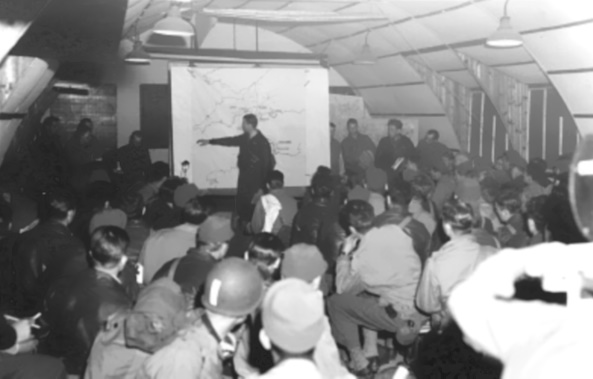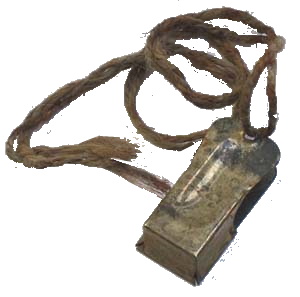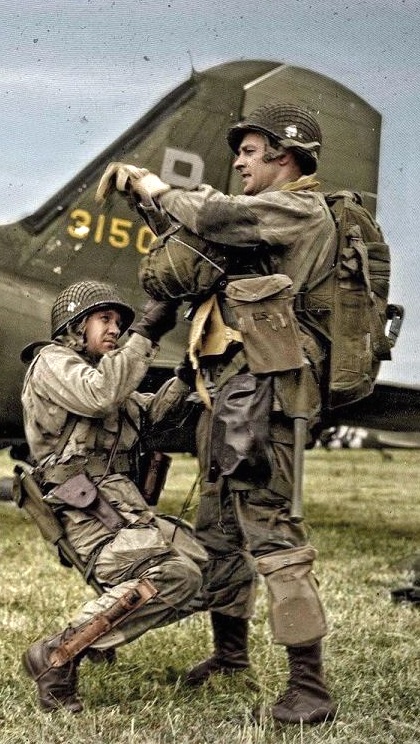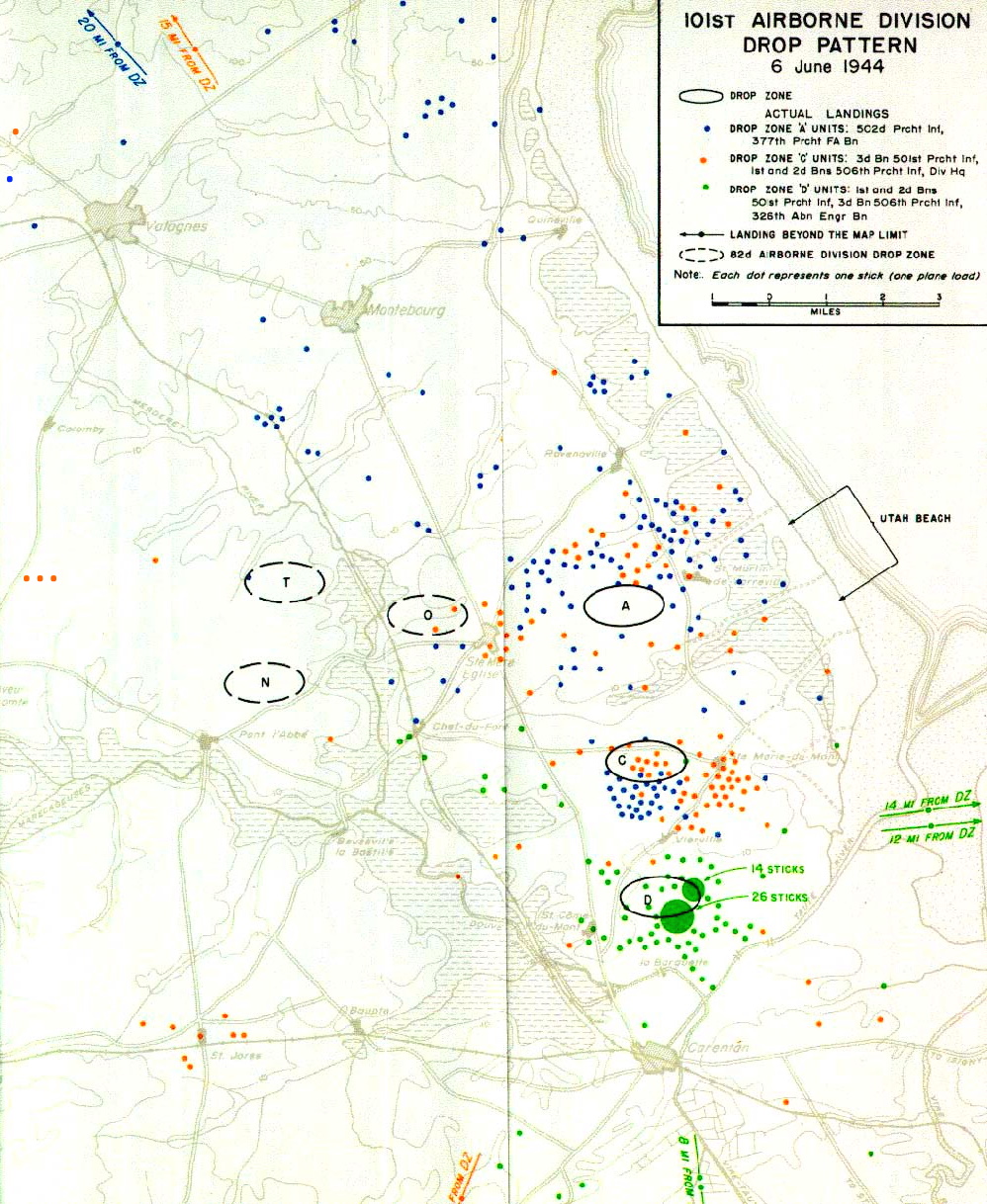Preparations
These and most of the other planning details were settled prior to May 29, 1944, when the Regiment was sealed in its marshaling areas at airfields in the south of England. There, the first order of business was the orientation and briefing of troops. For this purpose, paper-mache models of the area, including the drop zones and objectives, had been previously prepared and were issued to the units. Briefings were done by platoon. Initially, the battalion staff officers and company commanders were briefed, then each platoon leader brought his platoon into the briefing tent for a complete orientation on the enemy situation. The missions of the regiment, the objectives of each battalion, the regimental, battalion, and company plans, and the terrain, paying particular attention to the drop zones and the routes to the objectives, were studied.
As the 1/506 was to be in Regimental reserve, Col William A. Turner, the battalion CO, personally briefed each platoon of his battalion on his plan for the execution of any of the Regimental missions which the reserve battalion might inherit should anything happen to any of the other battalions. A platoon of Able Co studied the routes’ Carentan – Cherbourg cable and a platoon of Baker Co paid particular attention to the terrain south of St Marie du Mont. It must be kept in mind that at the time of this operation one battalion consisted of one Hqs Co and three Rifle Cos. One Hqs Co consisted of one Hqs, one 81-MM Mortar Platoon (4 Mortars), one machine-gun Platoon (8 MGs), one Signal Platoon, and one Rocket Launcher Section (this was not authorized by TO&E).
The Rifle Cos consisted of one HQs and three Platoons of two Rifle Squads and a 60-MM Mortar Squad each. The total strength of each Rifle Co was 128 men and 8 officers and the total strength of the battalion with medical and other attachments was slightly over 600. Following the initial orientation, maps were distributed in three scales. Quantities were sufficient that each enlisted man received a 1/100.000 map of the entire Cotentin Peninsula. Each officer, first sergeant, and mortar squad leader received 1/50.000 sheets of the division zone of responsibility, and each officer platoon sergeant, and mortar squad leader received a set of 1/25.000 maps of the division area. As the complete set in the latter two scales was too voluminous for one individual to carry, the recipient selected those sheets which he considered to be of utmost tactical value and distributed the other sheets to individuals of his command. In addition to these, a specially prepared night map of the drop zone and immediate vicinity was distributed to each individual. This map consisted of a 1/7500 vertical photo of the center of the drop zone, surrounded by sketches of the adjacent countryside as it might appear from an elevation of 1000 feet over the center of the drop zone. These maps were studied by individuals, squads, and platoons.
Road nets were sketched and memorized, and, finally, each platoon visited the briefing tent to study the terrain model at least one more time. This substitution for a ground reconnaissance prior to an attack was carried on concurrently with the distribution of special equipment. The lack of ammunition carriers made the resupply of mortar and machine-gun ammunition a serious problem. In an attempt to solve this problem, each individual not a member of a machine-gun or mortar crew was required to carry either a belt of ammunition or a 60-MM mortar round. Additional ammunition for these weapons was put in bundles (Aerial Delivery Containers) to be dropped from the racks of the airplanes. AT defense was to be initially confined to the rocket launchers carried in the platoons.
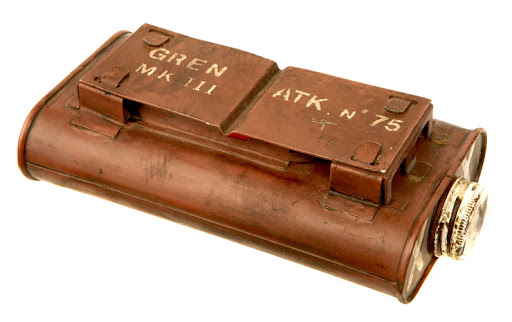 Experience had indicated that the tubes of these weapons were frequently bent or otherwise damaged on dropping. Therefore, half of these weapons were to be dropped on the person of the gunners and the balance dropped in bundles from the racks. To supplement this meager AT defense, each individual was given a one-pound Mark III N°75
Experience had indicated that the tubes of these weapons were frequently bent or otherwise damaged on dropping. Therefore, half of these weapons were to be dropped on the person of the gunners and the balance dropped in bundles from the racks. To supplement this meager AT defense, each individual was given a one-pound Mark III N°75  Hawkins AT mine to be collected upon reaching the assembly areas. Phosphorescent discs were also issued for individual identification or night recognition. Special phosphorescent disks were made available to distinctively mark each squad bundle on the ground. Ordinary ten-cent-store metal crickets were distributed for challenging during the assembly – one clicks for the challenge; two clicks for the reply. The passwords for the first five days were memorized. Flight manifests were prepared. The chaplains held daily well-attended services. Letters were written and censored. Movies were shown nightly. Some athletic activities were arranged, although this was limited due to the need for security.
Hawkins AT mine to be collected upon reaching the assembly areas. Phosphorescent discs were also issued for individual identification or night recognition. Special phosphorescent disks were made available to distinctively mark each squad bundle on the ground. Ordinary ten-cent-store metal crickets were distributed for challenging during the assembly – one clicks for the challenge; two clicks for the reply. The passwords for the first five days were memorized. Flight manifests were prepared. The chaplains held daily well-attended services. Letters were written and censored. Movies were shown nightly. Some athletic activities were arranged, although this was limited due to the need for security.
While the marshaling tent camps had been erected several weeks prior to their occupancy, the grass in the center of the fields had not been trampled, and it was, therefore, prudent to limit traffic to the edge of the fields lest aerial reconnaissance reveals the presence of troops. A new type of individual first aid packet was made available, which contained a large dressing, a tourniquet, and a morphine syrette. Benzedrine tablets were issued to the company commanders and halazone tablets were issued to all. Gas-proof capes, vesicant detectors, and assault-type gas masks were issued. Our paratrooper’s combat uniform (M-1942) jumpsuit had been gas impregnated. Ranges were provided, where the last check of the weapons’ zero settings could be made. The troops were permitted to exchange the money in their possession for French francs. One thousand francs were entrusted to each company commander for use in paying guides. Pilot escape kits were signed out to each officer. The escape kit included in its rubberized-fabric container one thousand francs, a compass small enough to be concealed in the anus, a map of France printed on a piece of silk the size of a handkerchief, and a small steel file.
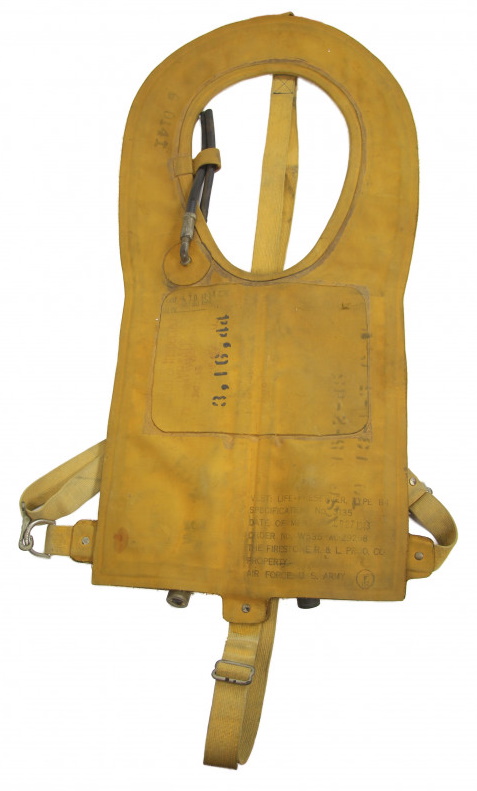
 British-type leg bags had been procured to be used by signal and radio operators as well as the members of weapons crews to permit them to descend with their equipment available for immediate action. Mae Wests and parachutes were issued, fitted and checked, then containers for rifles, sacks for machine gun belts, and ammunition were allotted. The basic load of small arms, crew-served weapons, ammunition, and grenades was prescribed for each individual. In addition to this, as much, additional ammunition of any type that an individual desired to carry was made available. Ordnance, Signal, and Quartermaster teams were present in the marshaling area to repair, replace, or issue any of the normal items of troop equipment. A service detachment prepared excellent meals. These service units relieved the units of all responsibilities and details that were humanly possible.
British-type leg bags had been procured to be used by signal and radio operators as well as the members of weapons crews to permit them to descend with their equipment available for immediate action. Mae Wests and parachutes were issued, fitted and checked, then containers for rifles, sacks for machine gun belts, and ammunition were allotted. The basic load of small arms, crew-served weapons, ammunition, and grenades was prescribed for each individual. In addition to this, as much, additional ammunition of any type that an individual desired to carry was made available. Ordnance, Signal, and Quartermaster teams were present in the marshaling area to repair, replace, or issue any of the normal items of troop equipment. A service detachment prepared excellent meals. These service units relieved the units of all responsibilities and details that were humanly possible.
Most of the details of preparation had been completed prior to D-1, so that day was devoted to last-minute adjustments of equipment, the final honing of trench knives, and rest. Supper on D-1 consisted of white bread, steak, and ice cream in addition to other more familiar items on the menu. At 2000, the men blackened their faces, buckled into their equipment, and marched to their planes on the airstrip; stopping en route at the hangar to pick up their parachutes and Mae Wests. While this was a short march, it was fatiguing, as the weight of equipment and parachute paraphernalia nearly doubled the weight of the individual. Pilots and jump masters checked the plane manifests, a jeep messenger delivered to each plane farewell messages from Montgomery and Eisenhower, the motors were turned over, motion sickness pills were taken, and at 2310 the battalion was airborne.
Taking off from Upottery Field, in addition to the 1/506, was the Regimental Hqs serial, and a battalion from the 501-PIR, also scheduled to land on DZ-C. The 3/506 had taken off from Exeter Airfield with another battalion of the 501-PIR, which was bound for DZ-D. The joint briefing of pilots and jump masters on D-2 had thoroughly covered Rendez-Vous areas for all elements of the division, serial composition, time and space between serials, routes of all serials to and from the drop areas, and particular stress had been given to the drop signals. It had been prescribed that a tight formation would be flown, the altitude over the drop zone was to be a minimum of 600 feet (180 M) and a maximum of one 1000 feet (300 M), and airspeed was to be approximately 110 MPH (175 KMH) while parachutists were jumping. The crew chief would notify the jumpmaster when the planes were ten minutes away from the DZ. A red light would be flashed five minutes away from the DZ and all planes of a serial would flash a green light simultaneously, the GO signal when the serial leader had passed over the pathfinders’ T and signaled the other planes from his astrodome. Pathfinder markings would consist of the location of radar and radio homing sets at the bisection of the two green electrically lighted lines of the Ts. Pathfinders would fly slightly different routes and would arrive on the ground one-half hour before the combat serials.
The takeoff, serial Rendez-Vous, and formation of the skytrains were uneventful. The air was calm, the anti-motion pills had tended to make the men drowsy, and the formation was extremely tight. Two-ground checkpoints, the Bill of Portland and the Portland Light Ship, were passed and everything appeared propitious for a successful jump when the coast of France 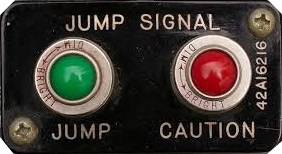 was clearly sighted some fifteen hundred feet below. Just inland of the coast, the formation entered a dense cloud or fog bank. The pilots immediately compensated for this by taking some intervals. As the fog grew even denser and visibility dropped to zero, pilot apprehension could be detected in that the planes were not handled as smoothly as before. To add to the difficulties of poor vision, light flak was experienced and some ships were shot down. Upon flying out of the fog into a clear sky, the arcs of small arms tracers could be observed looping up from the ground.
was clearly sighted some fifteen hundred feet below. Just inland of the coast, the formation entered a dense cloud or fog bank. The pilots immediately compensated for this by taking some intervals. As the fog grew even denser and visibility dropped to zero, pilot apprehension could be detected in that the planes were not handled as smoothly as before. To add to the difficulties of poor vision, light flak was experienced and some ships were shot down. Upon flying out of the fog into a clear sky, the arcs of small arms tracers could be observed looping up from the ground.
The pilots, disregarding their orders, took violent evasive action, some diving to treetop level, others climbing, turning, and doing whatever could be done to avoid the light ground fire. The formation left after leaving the fog was soon entirely dissipated, and with it went tactical unity and all of the carefully made plans to land in mass on the drop fields. Jumpmaster reports indicated that elements of the planes tended to stay together, which was some small consolation. The speed of ground assembly is directly proportional to the concentration of planes in the air. Experience has proven that the conditions for an ideal jump assembly are: (1) minimum distance in depth and width of serial/effect the greatest concentration of parachutists in the air; (2) calm air and minimum airspeed, short of stalling, prevent dispersion due to both drift and the extended interval between the first and last men out of the planes; (3) flat even terrain to prevent minor injuries on landing, and to give an unobstructed view of the entire drop zone; (4) experienced troops.
Assembly training had been extensive, both after actual jumps and simulated jumps. The best possible jump fields had been selected. The air was calm, but the factors of airspeed and flight concentration were not under the control of the tactical commander, and consequently, the speedy assembly of troops and prompt execution of the missions appeared to be doomed to failure as predicted.
The Drop
Some sticks were dropped as far as twenty miles away from the nearest drop zone. The majority of the jump masters reported they did not see their crew chiefs after they were airborne; most got a warning light at varying times from the drop; airspeeds seemed to be excessive, although this was only a matter of opinion; and jump altitudes varied from four hundred feet to fifteen hundred feet. Some sticks were dropped so near to the coast that the last few men in the sticks landed in the water.
DZ-A, 502-PIR, 377-PFAB.
DZ-C, 3/501-PIR, 1/506-PIR, 2/506-PIR, Div HQs-506-PIR.
DZ-D, 1/501-PIR, 2/501-PIR, 2/506-PIR, 326-AEB.
DZ-T, DZ-N and DZ-O, 82-Abn.










